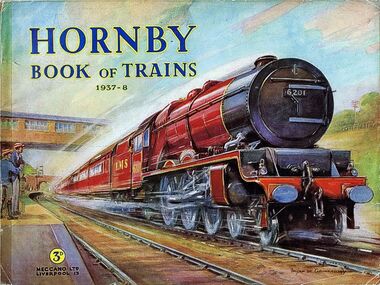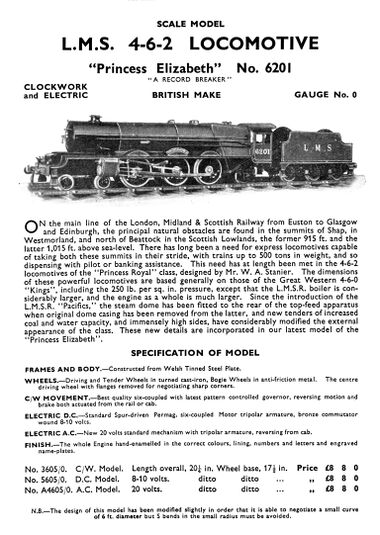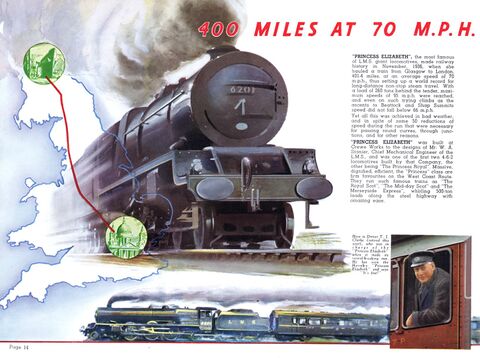Category:Princess Elizabeth (loco)
The Princess Elizabeth on the cover of the Hornby Book of Trains, 1937-38.
This picture doesn't obviously show the locomotive's distinctive tapered boiler, but this might be a legitimate result of compensating perspective, rather than a mistake by the artist [image info]
Bassett-Lowke gauge 0 model of the Princess Elizabeth, 1937 [image info]
The 4-6-2 Princess Elizabeth locomotive (running number 6201) ran from 1933 to 1962, and is currently preserved in working condition.
It was built and run by LMS, and was later run by British Rail under the number 46201.
Diamond Jubilee, 2012
The locomotive was recently used in the Queen Elizabeth II's Diamond Jubilee celebrations, on 3 June 2012. The loco was parked on Battersea Railway Bridge, above the River Thames, and blew a whistle salute to start the pageant.
Development
The Princess Elizabeth was the second example of the Princess Royal Class of express passenger locomotives designed by Stanier, and known as "Lizzies".
The Princess Royal Class took over the duties of the Royal Scot Class in pulling the "Royal Scot" train. The Lizzies were much prettier and more elegant-looking than the original Royal Scots, and had a long tapered boiler that was much nicer on the eye than the more clunky cylindrical boilers that the Scots were originally fitted with.
After Stanier's "Lizzie" design had been proven in use, Stanier was authorised to design a larger and more powerful version, which became the 1937 Coronation Class (with streamlining), or the Duchess Class (without streamlining).
Record-breaking run
The locomotive set a new long-distance world speed record in 1936, achieving over 70mph on average over just over 400 miles of track. The driver, Driver Clarke, went on to take Coronation 6220 on its world-breaking run in 1937.
1938 Meccano Ltd. promotional text:
"400 Miles at 70 m.p.h."
- " "PRINCESS ELIZABETH", the most famous of LMS giant locomotives, made railway history in November, 1936, when she hauled a train from Glasgow to London, 401.4 miles, at an average speed of 70 m.p.h., this setting up a world record for long-distance non-stop steam travel. With a load of 260 tons behind the tender, maximum speeds of 95 m.p.h. were reached, and even on such trying climbs as the ascents to Beattock and Shap Summits speed did not fall below 66 m.p.h.
- Yet all this was achieved in bad weather, and in spite of some 50 reductions of speed during the run that were necessary for passing around curves, though junctions, and for other reasons.
- "PRINCESS ELIZABETH" was built at Crewe Works to the designs of Mr. W. A. Stanier, Chief Mechanical Engineer of the L.M.S., and was one of the first two 4-6-2 locomotives built by that Company, the other being "The Princess Royal". Massive, dignified, efficient, the "Princess" class are firm favourites on the West Coast Route. They run such famous trains as "The Royal Scot", "The Mid-Day Scot and "The Merseyside Express", whirling 500-ton loads along the steel highway with amazing ease. "
"Princess" / "Princess Royal" Class
- 6200 – Princess Royal
- 6201 – Princess Elizabeth
- 6203 – experimental "Turbomotive", unnamed.
Rebuilt in 1952 as the Princess Anne. Wrecked 1952 in the Harrow and Wealdstone Rail Crash.
- 6203 – Princess Margaret Rose
- 6204 – Princess Louise
- 6205 – Princess Victoria
- 6206 – Princess Marie Louise
- 6207 – Princess Arthur of Connaught
- 6208 – Princess Helena Victoria
- 6209 – Princess Beatrice
- 6210 – Lady Patricia
- 6211 – Queen Maud
- 6212 – Duchess of Kent
In the Museum
The Museum has two examples of the Hornby gauge 0 "Princess Elizabeth" locomotive, one boxed and one on the central Gauge 0 model railway layout, and also a Trix model.
Pages in category ‘Princess Elizabeth (loco)’
The following 4 pages are in this category, out of 4 total.
Media in category ‘Princess Elizabeth (loco)’
The following 13 files are in this category, out of 13 total.
- Bassett-Lowke, Princess Elizabeth, gauge 0 (BL-MR 1937-11).jpg 1,536 × 2,164; 511 KB
- CKD Completely Knocked Down kits, Triang Railways (TRCat 1963).jpg 1,705 × 2,200; 869 KB
- HBOT 1938-39 p14 Princess Elizabeth loco.jpg 1,636 × 1,221; 345 KB
- HBOT 1938-39 p15 Princess Elizabeth model.jpg 1,638 × 1,235; 575 KB
- Hornby Book of Trains cover 1937-38.jpg 661 × 496; 138 KB
- Hornby Princess Elizabeth (1939- catalogue).jpg 2,292 × 982; 353 KB
- Hornby Princess Elizabeth (MM1937-09).jpg 1,605 × 2,146; 626 KB
- Hornby Princess Elizabeth 6201 locomotive detail.jpg 1,024 × 768; 384 KB
- Hornby Princess Elizabeth locomotive 6201 (1939 catalogue).jpg 2,464 × 1,592; 601 KB
- Hornby Trains Princess Elizabeth 6201 (MM 1938-11).jpg 2,310 × 1,455; 574 KB
- Princess Elizabeth 6201 ad (Meccano No 9-10 manual).jpg 2,438 × 1,487; 865 KB
- Triang Railways, catalogue front cover (TRCat 1956).jpg 1,600 × 1,231; 582 KB
- Trix Princess.jpg 2,048 × 1,391; 324 KB


















